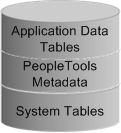PeopleSoft Database
PeopleSoft has a long history of offering customers a choice of market-leading databases. PeopleTools provides an abstraction layer, which insulates application developers from the intricacies of each of the specific database platforms. Customer databases choices include:
Oracle
IBM Db2
Microsoft SQL Server
After you install your database engine there are three distinct layers within the database that work in concert to store and manage data for your PeopleSoft system. The database system tables manage both the PeopleTools and PeopleSoft application database objects, while the PeopleSoft application tables reside within the infrastructure defined by the PeopleTools metadata.
The following image describes three distinct yet integrated database layers for PeopleSoft system.

The following table describes each layer of a PeopleSoft database.
|
PeopleSoft Database Layer |
Description |
|---|---|
|
System Tables |
System tables, also called system catalog tables, are analogous to a table of contents for a book or to file allocation tables on a hard drive. The structure and table names vary depending on which RDBMS you use. System catalog tables:
|
|
PeopleTools metadata |
PeopleTools tables provide the infrastructure for PeopleSoft applications by storing and managing PeopleSoft application metadata. This metadata consists of information that defines the application, such as records, fields, pages, PeopleCode, and security. PeopleTools tables:
|
|
PeopleSoft application data tables |
Application data tables store data entered through a PeopleSoft application. The specific tables and their structures vary by application. Application data tables:
|